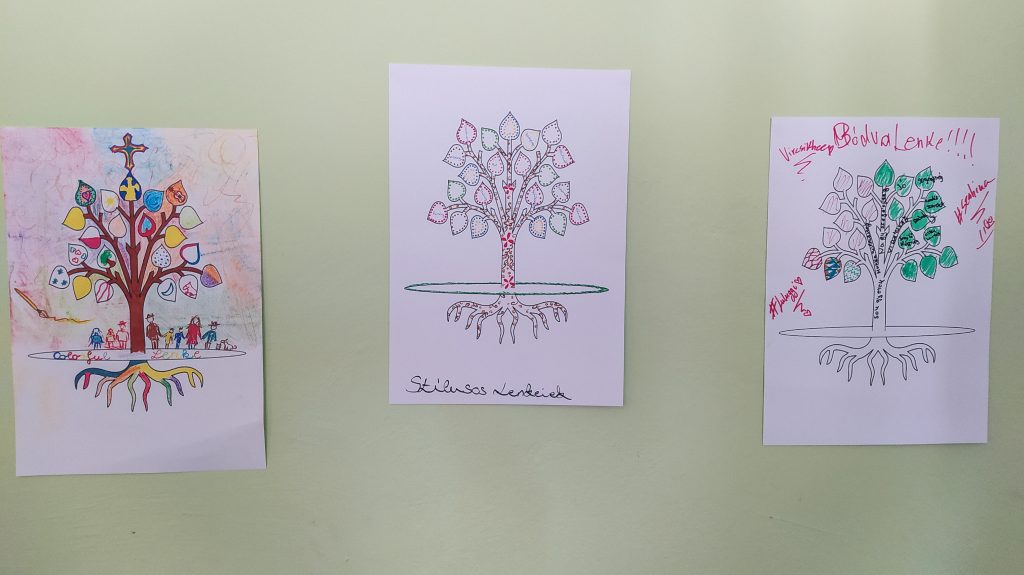Activity 15 : Tree of Life
Overview of the activity
The visual metaphor of trees will be used as a structure to label different elements of the participants’ lives, culture, identity and strengths, linked to the past, present and future. It gives participants the opportunity to share short personal stories about the elements of their tree.
Objectives
- Increase self-awareness
- Better understand our values and goals
- Gain meaning from our own story and reflect on the heritage elements that mean the most to us
| Duration (in minutes) | Min/max number of participants | Room/space requirements |
| 60 minutes |
|
No requirements |
| Minimum knowledge requirements from participants | Materials needed | Preparation |
| n/a |
|
None required |
Instructions
- Ask participants to close their eyes and think about a tree, the seed it once came from, its roots in the ground, the trunk, the branches, the leaves, the fruit that grows from it. Take time over this, give them space to really visualize the tree. How does it smell, sound, move? Then, ask the participants to imagine that each part of the tree could represent parts of a life.
- Now ask participants to take a large sheet of paper and a pen and draw the outline of a simple tree. Let them know they are going to be adding words in and around the tree, so they should leave space for this. It is not about the artistic quality of the drawing, the idea is just that imagining the form of a tree will help us structure our thoughts. To guide the participants, you might also draw a tree on a flipchart page as an example, introducing the necessary elements of the tree. Ask the participants to consider the following questions and ideas for each section of the tree.

Roots
- Where and who do you come from? For example, can participants add the names of family, family members, people who feel like family. (Be aware that family could be a sensitive subject for some participants, such as refugees and people from state care.)
- Where were you born, where did you live? Consider treasured childhood places, activities, traditions, events, habits, rituals you enjoyed from your childhood that shaped you (Clarification: It is not possible to capture everything, record the elements that feel important or simply the thoughts that come first).
The ground in which the tree grows
- What do you occupy yourself with in everyday life? Work, hobbies and other activities you like or which you have to spend time on. Where do you live, who do you see on a daily basis?
The trunk
- This represents your values, character, skills and abilities. Think about what values are important to you. What are you good at and what do you most enjoy? Write your skills and values on the trunk.
The branches
- What are your wishes and dreams for the future?
- What do you want to achieve? Think about big branches and small branches, the long term as well as the short term.
The leaves
- Write the names of significant people in your life, those who have helped you get where you are today and those who can help you fulfill your wishes and dreams in the future. These names could refer to people with whom you have had supportive or even difficult relationships.
The fruit
- The fruit represents what you want to leave behind. What do you hope your legacy will be, your gift to humankind? This can be material, such as an inheritance, but most often this will be attributes such as courage, kindness, generosity, etc.
Falling leaves
- These leaves represent what you might wish to let go of, becoming a part of the ground they grew from, not for the future.
Learning outcomes / evidence collected

Evaluation
Once participants have completed their trees, invite them to answer questions designed to help them consider their tree and its meanings from various perspectives, and open up a general discussion about their trees and the exercise more generally.
- What species of tree did you draw?
- Which part of your tree takes up the most space?
- Which part takes up the least space?
- Which parts were easy to do?
- Which parts got least attention?
- Which parts of your tree are connected to your cultural heritage (ethnic, national, religious etc.)?
- Did anything surprise you?
- Could you share your tree with someone supportive?
- Could they add something positive you may have missed?
Participants can share their answers to these questions and their tree with the rest of the group. This also gives them the opportunity to share short personal stories about the elements of their tree.
Teaching tips, stories and experiences during piloting
- We encourage you to try the exercise yourself before introducing it to a group. This work is deeply personal and can release intense emotions. It requires preparation in terms of bringing the group together and creating a safe space.
- Some participants may feel that the tree they have drawn is too personal and do not want to show it to others.
